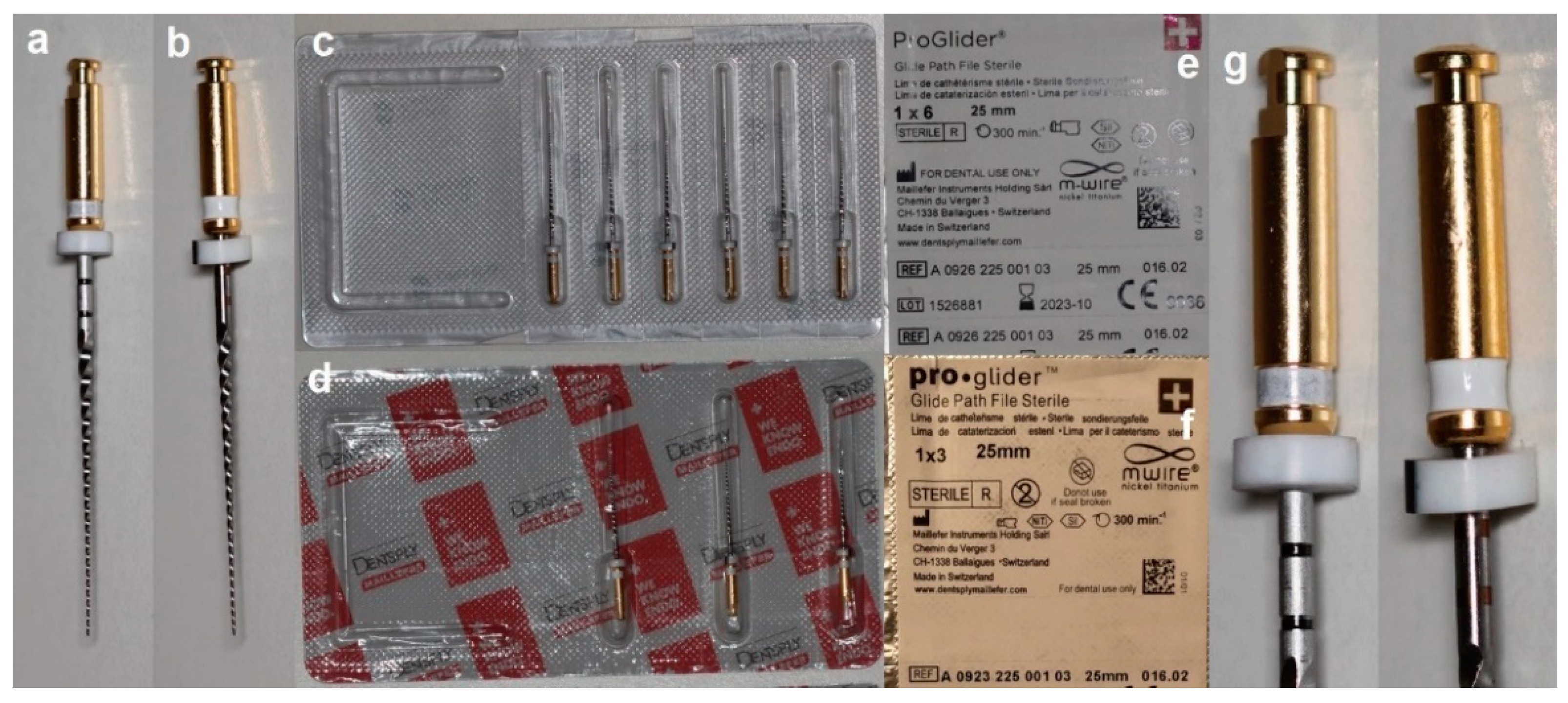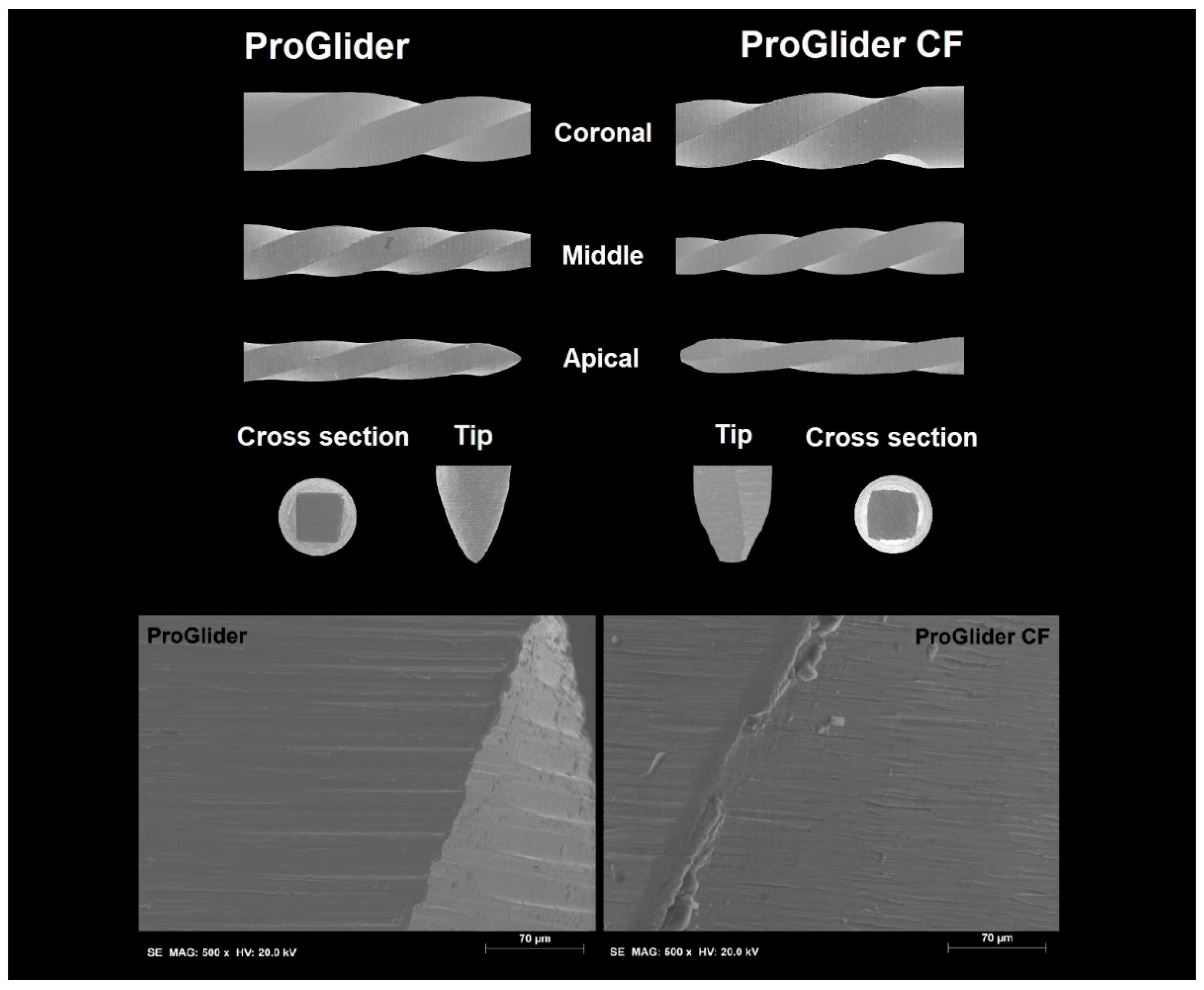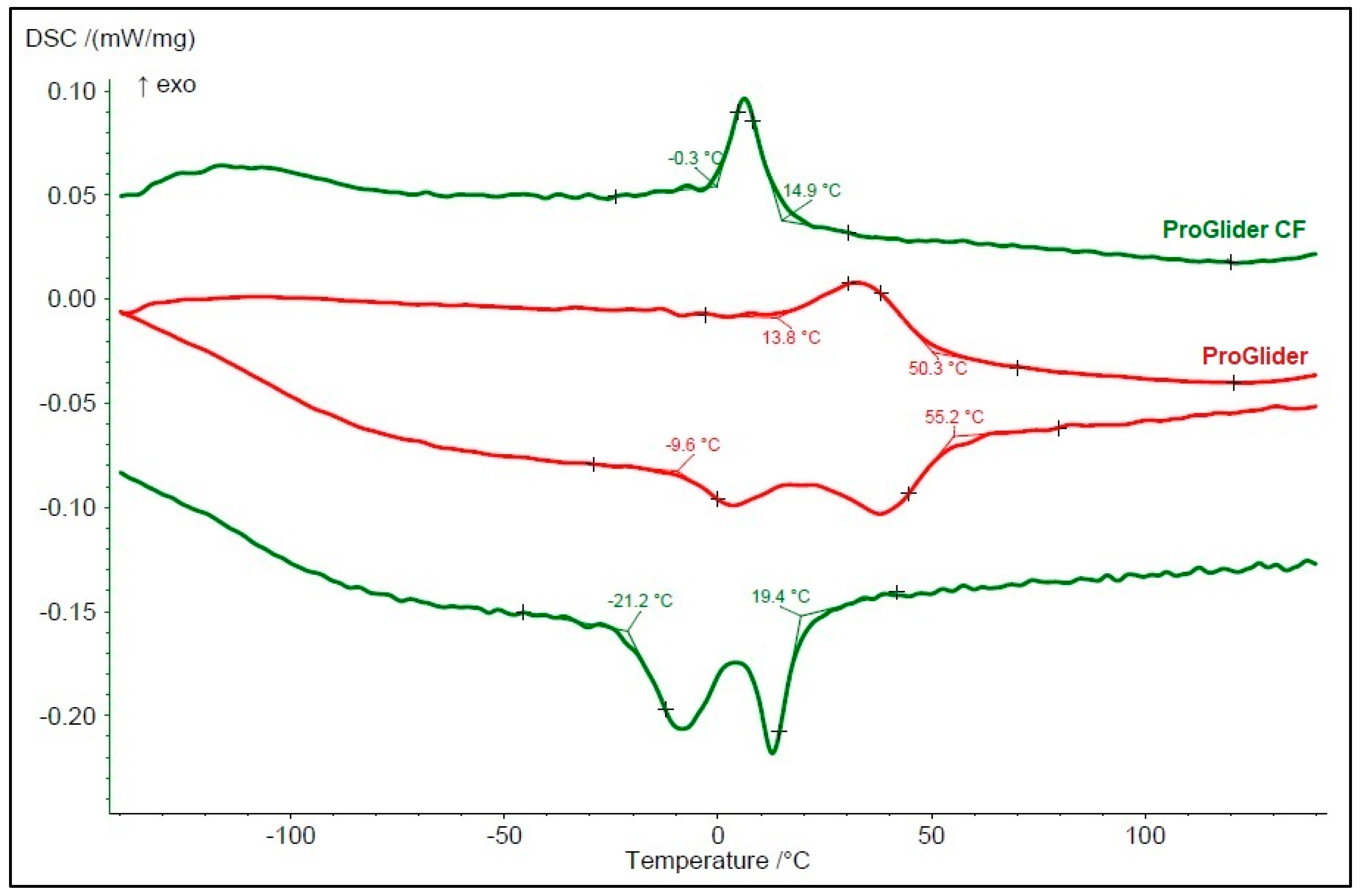Multimethod Assessment of Design, Metallurgical, and Mechanical Characteristics of Original and Counterfeit ProGlider Instruments
Abstract
:1. Introduction
2. Materials and Methods
2.1. Instruments’ Design
2.2. Metallurgical Characterization
2.3. Mechanical Tests
2.4. Statistical Analysis
3. Results
3.1. Instruments’ Design
3.2. Metallurgical Characterization
3.3. Mechanical Tests
4. Discussion
5. Conclusions
Author Contributions
Funding
Institutional Review Board Statement
Informed Consent Statement
Conflicts of Interest
References
- West, J.D. The endodontic glidepath: “secret to rotary safety”. Dent. Today 2010, 29, 90–93. [Google Scholar] [PubMed]
- Van der Vyver, P.J. Creating a glide path for rotary NiTi instruments: Part one. Int. Dent. J. 2010, 13, 6–10. [Google Scholar]
- Martins, J.N.R.; Silva, E.J.N.L.; Marques, D.; Belladonna, F.; Simoes-Carvalho, M.; Camacho, E.; Braz Fernandes, F.M.; Versiani, M.A. Comparison of design, metallurgy, mechanical performance and shaping ability of replica-like and counterfeit instruments of the ProTaper Next system. Int. Endod. J. 2021, 54, 780–792. [Google Scholar] [CrossRef] [PubMed]
- Remedies; Infringement; Innocent Infringement by Printers and Publishers—Commerce and Trade; United States Code; Legal Information Institute: Ithaca, NY, USA, 2006; p. 1127.
- Rodrigues, C.S.; Vieira, V.T.L.; Antunes, H.S.; De-Deus, G.; Elias, C.N.; Moreira, E.J.L.; Silva, E.J.N.L. Mechanical characteristics of counterfeit Reciproc instruments: A call for attention. Int. Endod. J. 2018, 51, 556–563. [Google Scholar] [CrossRef] [PubMed]
- Martins, J.N.R.; Silva, E.J.N.L.; Marques, D.; Pereira, M.R.; Ginjeira, A.; Silva, R.J.C.; Braz Fernandes, F.M.; Versiani, M.A. Mechanical performance and metallurgical features of ProTaper Universal and 6 replicalike systems. J. Endod. 2020, 46, 1884–1893. [Google Scholar] [CrossRef] [PubMed]
- Parashos, P.; Messer, H.H. Rotary NiTi instruments fracture and its consequences. J. Endod. 2006, 32, 1031–1043. [Google Scholar] [CrossRef] [PubMed]
- Hulsmann, M.; Peters, O.A.; Dummer, P.M.H. Mechanical preparation of root canals: Shaping goals, techniques and means. Endod. Topics 2005, 10, 30–76. [Google Scholar] [CrossRef]
- ASTM F2004–17. Standard Test Method for Transformation Temperature of Nickel-Titanium Alloys by Thermal Analysis. ASTM International: West Conshohocken, PA, USA, 2004; pp. 1–5.
- Silva, E.; Martins, J.N.R.; Lima, C.O.; Vieira, V.T.L.; Fernandes, F.M.B.; De-Deus, G.; Versiani, M.A. Mechanical tests, metallurgical characterization and shaping ability of nickel-titanium rotary instruments: A multimethod research. J. Endod. 2020, 46, 1485–1494. [Google Scholar] [CrossRef] [PubMed]
- ISO3630-3631. Dentistry—Root Canal Instruments—Part 1: General Requirements and Test Methods. International Organization for Standardization: Geneve, Switzerland, 2008.
- ANSI/ADASpecificationN°28-2002. Root Canal Files and Reamers, Type K for Hand Use; American National Standards: Washington, DC, USA, 2002. [Google Scholar]
- Locke, M.; Thomas, M.B.; Dummer, P.M. A survey of adoption of endodontic nickel-titanium rotary instrumentation part 1: General dental practitioners in Wales. Br. Dent. J. 2013, 214, E6. [Google Scholar] [CrossRef] [PubMed]
- Hunter, A.; Brewer, J.D. Designing multimethod research. In The Oxford Handbook of Multimethod and Mixed Methods Research Inquiry; Hesse-Biber, S., Johnson, R.B., Eds.; Oxford University Press: Oxford, UK, 2015. [Google Scholar]
- McSpadden, J.T. Mastering instrument designs. In Mastering Endodontics Instrumentation; McSpadden, J.T., Ed.; Cloudland Institute: Chattanooga, TN, USA, 2007; pp. 37–97. [Google Scholar]
- Anderson, M.E.; Price, J.W.; Parashos, P. Fracture resistance of electropolished rotary nickel-titanium endodontic instruments. J. Endod. 2007, 33, 1212–1216. [Google Scholar] [CrossRef] [PubMed]
- Hieawy, A.; Haapasalo, M.; Zhou, H.; Wang, Z.J.; Shen, Y. Phase transformation behavior and resistance to bending and cyclic fatigue of ProTaper Gold and ProTaper Universal instruments. J. Endod. 2015, 41, 1134–1138. [Google Scholar] [CrossRef] [PubMed]
- Kaval, M.E.; Capar, I.D.; Ertas, H. Evaluation of the cyclic fatigue and torsional resistance of novel nickel-titanium rotary files with various alloy properties. J. Endod. 2016, 42, 1840–1843. [Google Scholar] [CrossRef] [PubMed]
- McSpadden, J.T. Mastering the concepts. In Mastering Endodontics Instrumentation; McSpadden, J.T., Ed.; Cloudland Institute: Chattanooga, TN, USA, 2007; pp. 7–36. [Google Scholar]
- Campbell, L.; Shen, Y.; Zhou, H.M.; Haapasalo, M. Effect of fatigue on torsional failure of nickel-titanium controlled memory instruments. J. Endod. 2014, 40, 562–565. [Google Scholar] [CrossRef] [PubMed] [Green Version]
- Elnaghy, A.M.; Elsaka, S.E. Mechanical properties of ProTaper Gold nickel-titanium rotary instruments. Int. Endod. J. 2016, 49, 1073–1078. [Google Scholar] [CrossRef] [PubMed]
- Hulsmann, M.; Donnermeyer, D.; Schafer, E. A critical appraisal of studies on cyclic fatigue resistance of engine-driven endodontic instruments. Int. Endod. J. 2019, 52, 1427–1445. [Google Scholar] [CrossRef] [PubMed] [Green Version]
- Vasconcelos, R.A.; Murphy, S.; Carvalho, C.A.; Govindjee, R.G.; Govindjee, S.; Peters, O.A. Evidence for reduced fatigue resistance of contemporary rotary instruments exposed to body temperature. J. Endod. 2016, 42, 782–787. [Google Scholar] [CrossRef] [PubMed] [Green Version]
- Lopes, W.S.P.; Vieira, V.T.L.; Silva, E.; Silva, M.C.D.; Alves, F.R.F.; Lopes, H.P.; Pires, F.R. Bending, buckling and torsional resistance of rotary and reciprocating glide path instruments. Int. Endod. J. 2020, 53, 1689–1695. [Google Scholar] [CrossRef] [PubMed]



| System | Metal Alloy | Category | Manufacturer Specifications | Identification (Color Coding) | Acquisition (Country) | Lot | Reference Price ** |
|---|---|---|---|---|---|---|---|
| PG-OR | M-Wire | Premium brand | Dentsply (Ballaigues, Switzerland) | White ring | Local market (Portugal) | 1526881 | 1.00 |
| PG-CF * | M-Wire | Counterfeit | Dentsply (Ballaigues, Switzerland) | White ring | Internet (China) | 1370977 | 0.26 |
| System | n | Number of Blades | Helical Angle (in °) | Measuring Lines Position (in mm) | Defects or Deformations | |
|---|---|---|---|---|---|---|
| 20 mm | 22 mm | |||||
| PG-OR | 6 | 21 | 21.4 [20.6–21.9] | 19.9 [19.7–20.0] | 22.0 [21.9–22.1] | 0 |
| PG-CF | 6 | 21 | 21.9 [20.9–22.7] | 20.7 [20.6–20.9] | 22.7 [22.6–22.8] | 0 |
| System | Cyclic Fatigue Test | Torsional Test | Bending Test | ||
|---|---|---|---|---|---|
| Time to Fracture (in Seconds) | Fragment Length (in mm) | Maximum Torque (in N·cm) | Angle of Rotation (in °) | Maximum Load (in gf) | |
| PG-OR | 118.0 (±13.7) 123.5 [106.5–128.5] | 6.9 (±0.2) 7.0 [6.9–7.1] | 0.4 (±0.1) 0.4 [0.3–0.5] | 440.0 (±27.5) 439.0 [413.3–467.0] | 146.3 (±11.5) 145.9 [141.7–150.9] |
| PG-CF | 34.1 (±5.4) 34.0 [30.3–36.5] | 6.8 (±0.7) 6.8 [6.2–7.6] | 0.4 (±0.1) 0.4 [0.3–0.5] | 361.3 (±37.2) 361.5 [329.0–400.0] | 246.7 (±17.7) 246.5 [239.0–262.6] |
| p-value | <0.001 | 0.627 | 0.798 | <0.001 | <0.001 |
Publisher’s Note: MDPI stays neutral with regard to jurisdictional claims in published maps and institutional affiliations. |
© 2022 by the authors. Licensee MDPI, Basel, Switzerland. This article is an open access article distributed under the terms and conditions of the Creative Commons Attribution (CC BY) license (https://creativecommons.org/licenses/by/4.0/).
Share and Cite
Martins, J.N.R.; Silva, E.J.N.L.; Marques, D.; Arantes-Oliveira, S.; Ginjeira, A.; Caramês, J.; Braz Fernandes, F.M.; Versiani, M.A. Multimethod Assessment of Design, Metallurgical, and Mechanical Characteristics of Original and Counterfeit ProGlider Instruments. Materials 2022, 15, 3971. https://doi.org/10.3390/ma15113971
Martins JNR, Silva EJNL, Marques D, Arantes-Oliveira S, Ginjeira A, Caramês J, Braz Fernandes FM, Versiani MA. Multimethod Assessment of Design, Metallurgical, and Mechanical Characteristics of Original and Counterfeit ProGlider Instruments. Materials. 2022; 15(11):3971. https://doi.org/10.3390/ma15113971
Chicago/Turabian StyleMartins, Jorge N. R., Emmanuel J. N. L. Silva, Duarte Marques, Sofia Arantes-Oliveira, António Ginjeira, João Caramês, Francisco M. Braz Fernandes, and Marco A. Versiani. 2022. "Multimethod Assessment of Design, Metallurgical, and Mechanical Characteristics of Original and Counterfeit ProGlider Instruments" Materials 15, no. 11: 3971. https://doi.org/10.3390/ma15113971
APA StyleMartins, J. N. R., Silva, E. J. N. L., Marques, D., Arantes-Oliveira, S., Ginjeira, A., Caramês, J., Braz Fernandes, F. M., & Versiani, M. A. (2022). Multimethod Assessment of Design, Metallurgical, and Mechanical Characteristics of Original and Counterfeit ProGlider Instruments. Materials, 15(11), 3971. https://doi.org/10.3390/ma15113971










